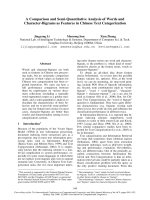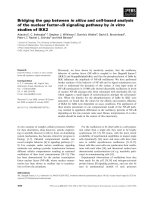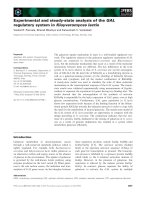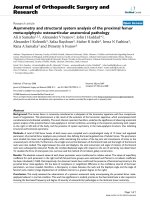Design, fabrication and thrust drag analysis of improved fish robots actuated by piezoceramic composite actuators
Bạn đang xem bản rút gọn của tài liệu. Xem và tải ngay bản đầy đủ của tài liệu tại đây (300.41 KB, 10 trang )
Design, Fabrication and Thrust/Drag
Analysis of Improved Fish Robots Actuated
by Piezoceramic Composite Actuators
Nguyen, Quang Sang
Thesis of the Doctor of Philosophy
Department of Advanced Technology Fusion
Graduate School of Konkuk University
Design, Fabrication and Thrust/Drag
Analysis of Improved Fish Robots Actuated
by Piezoceramic Composite Actuators
Nguyen, Quang Sang
Thesis of the Doctor of Philosophy
Department of Advanced Technology Fusion
Graduate School of Konkuk University
Design, Fabrication and Thrust/Drag
Analysis of Improved Fish Robots Actuated
by Piezoceramic Composite Actuators
Nguyen, Quang Sang
A Dissertation Submitted to the Department of Advanced Technology Fusion
and the Graduate School of Konkuk University
in partial fulfillment of the requirements
for the degree of Doctor of Philosophy
August 2010
Approved by
Park, Hoon Cheol
Major Advisor
Table of Content
List of Figures ........................................................................................................... v
List of Tables............................................................................................................ ix
ABSTRACT .............................................................................................................. x
1.
Introduction....................................................................................................... 1
1.1
2.
Understanding fish swimming................................................................. 1
1.1.1
Reynolds number .............................................................................. 5
1.1.2
Froude number: ................................................................................ 6
1.1.3
Strouhal number ............................................................................... 6
1.2
Overview of research on fish ................................................................... 7
1.3
Overview of research on fish robot driven by electromagnetic motor .... 8
1.4
Overview of fish robot driven by smart material .................................. 14
1.5
Objective and approach ......................................................................... 21
A fish robot driven by piezoceramic actuators ............................................ 24
2.1
Description of the fish robot .................................................................. 24
2.1.1
Actuator .......................................................................................... 25
2.1.2
Linkage design................................................................................ 26
2.1.3
External power supply .................................................................... 27
2.1.4
Miniaturized power supply ............................................................. 31
2.2
Swimming test ....................................................................................... 33
2.2.1
Linkage analysis ............................................................................. 33
i
2.2.2
Thrust measurement ....................................................................... 36
2.2.3
Wired-swimming test ..................................................................... 38
2.2.4
Free-swimming test ........................................................................ 38
2.3
2.3.1
Tail-beat angle ................................................................................ 39
2.3.2
Thrust.............................................................................................. 40
2.3.3
Swimming speed ............................................................................ 41
2.4
3.
Experimental result................................................................................ 39
Summary ............................................................................................... 43
An improved fish robot driven by piezoceramic actuators ......................... 44
3.1
Design and fabrication of the actuation system ..................................... 44
3.1.1
Actuator .......................................................................................... 44
3.1.2
Design and working principle of the linkage system ..................... 46
3.1.3
Linkage analysis ............................................................................. 48
3.1.4
Fabrication of the actuation system ................................................ 51
3.2
Fish robot configuration ........................................................................ 52
3.2.1
Tail fin of the fish robot.................................................................. 52
3.2.2
Description of the improved fish robot........................................... 53
3.3
Evaluation of the improved fish robot ................................................... 53
3.3.1
Tail-beat angle of the fish robot in water ....................................... 54
3.3.2
Swimming test of the fish robot ..................................................... 55
3.3.3
Thrust of the fish robot ................................................................... 58
3.3.4
Thrust coefficient............................................................................ 62
3.3.5
Turning swimming radius of the fish robot .................................... 63
ii
3.4
3.4.1
Reynolds number ............................................................................ 68
3.4.2
Froude number................................................................................ 68
3.4.3
Strouhal number ............................................................................. 70
3.5
4.
Summary ............................................................................................... 70
Thrust improvement by using Compressed LIPCAs .................................. 71
4.1
Fish robot ............................................................................................... 71
4.1.1
Actuator .......................................................................................... 71
4.1.2
Actuation mechanism ..................................................................... 72
4.1.3
Fish body ........................................................................................ 72
4.2
Experiment ............................................................................................ 73
4.2.1
Swimming experiment.................................................................... 73
4.2.2
Thrust Measurement ....................................................................... 77
4.2.3
Drag Estimation .............................................................................. 77
4.3
Result ..................................................................................................... 79
4.3.1
Swimming speed ............................................................................ 79
4.3.2
Thrust of the Fish Robot ................................................................. 80
4.3.3
Drag of the Fish Robot ................................................................... 80
4.3.4
Drag coefficient .............................................................................. 85
4.4
5.
Parameter study ..................................................................................... 68
Summary ............................................................................................... 86
CFD simulation ............................................................................................... 87
5.1
Simulation model................................................................................... 87
5.2
Model validation.................................................................................... 90
iii
5.3
6.
Results and discussions ......................................................................... 92
Concluding remarks and recommendations future work ......................... 100
6.1
Concluding remarks............................................................................. 100
6.2
Academic contribution ........................................................................ 102
6.3
Recommendation for future work ....................................................... 103
REFERENCE ....................................................................................................... 104
APPENDIX ........................................................................................................... 107
요약문 .................................................................................................................... 108
iv
List of Figures
Figure 1-1: Fish configuration [2] ......................................................................... 3
Figure 1-2: Swimming mode associated with (a) BCF propulsion and (b) MPF
propulsion [3] ........................................................................................................ 3
Figure 1-3: Diagram showing the relation between swimming propulsors and
swimming functions [4]......................................................................................... 4
Figure 1-4: (a) The forces acting on a swimming fish; (b) Pitch, yaw, and roll
definitions. [5] ....................................................................................................... 4
Figure 1-5: Typical velocity of the largest possible variety of swimmers as a
function of the Reynolds number [1] .................................................................... 6
Figure 1-6: Flow visualization of velocity field in the x-y planes [13] ............... 10
Figure 1-7: Viscous flow around a swimming fish: (a) mesh around the fish
model; (b) detail of a cut through the mesh [14]. ................................................ 10
Figure 1-8: Schematic view of the eight internal links of the MIT’s Robot Tuna
mechanism [18] ................................................................................................... 11
Figure 1-9: Draper Lab’s hydraulic-actuated Vorticity Control Unmanned
Undersea Vehicle’s configuration [19] ............................................................... 11
Figure 1-10: RoboPike [20] ................................................................................. 12
Figure 1-11: Design of Boxybot fish robot [21].................................................. 12
Figure 1-12: Prototype of the experimental robot fish [22] ................................ 13
Figure 1-13: Apparatus of pectoral fin motion [23] ............................................ 13
Figure 1-14: Pressure sensor and its location on the fish body [24]. .................. 15
Figure 1-15: Drag measurement apparatus [25] .................................................. 15
Figure 1-16: Geometry and position of neutral axis of LIPCA [28] ................... 17
Figure 1-17: An IPMC strip under a low voltage [29] ........................................ 17
Figure 1-18: Large actuation displacement and actuation force of SMA with low
responsiveness [31] ............................................................................................. 18
Figure 1-19: Lamprey robot actuated by SMA [32] ............................................ 18
v
Figure 1-20: Two type robots driven by IPMC [33] ........................................... 19
Figure 1-21: The tadpole robot: (a) configuration of the microrobot; (b)
miniaturized of the battery, electrode and embedded controller located inside the
body [34]. ............................................................................................................ 19
Figure 1-22: The floating boat driven by THUNDER [35]................................. 20
Figure 1-23: Fish robot actuated by two LIPCA: (a) Configuration of the fish
robot; (b) Linkage system.................................................................................... 20
Figure 2-1: Assembly of the fish ......................................................................... 25
Figure 2-2: Geometry and position of layers in a LIPCA ................................... 25
Figure 2-3: Linkage system of the fish robot ...................................................... 27
Figure 2-4: Function generator (Agilent 33220A) .............................................. 29
Figure 2-5: Voltage amplifier (MATSUSADA model AML-1.5B40-LC) ......... 29
Figure 2-6: Oscilloscope (Tektroniks TDS 2024) ............................................... 29
Figure 2-7: The schematic of the MIPAD ........................................................... 30
Figure 2-8: Hardware implementation of the MIPAD. ....................................... 32
Figure 2-9: MIPAD response to square wave command..................................... 32
Figure 2-10: Tail-beat angle analysis by vector calculus .................................... 34
Figure 2-11: Tail-beat angle measurement apparatus ......................................... 35
Figure 2-12: Load cell (Nano 17 Transducer) ..................................................... 36
Figure 2-13: The apparatus of the thrust measurement ....................................... 37
Figure 2-14: Schematic diagram of the wired-swimming test ............................ 37
Figure 2-15: Fish robot in the free-swimming test .............................................. 38
Figure 2-16: Tail-beat angle by vector calculus .................................................. 40
Figure 2-17: Tail-beat angle of the fish robot in water ....................................... 40
Figure 2-18: The average thrust of the fish robot ................................................ 42
Figure 3-1: Fabricated LIPCA. ............................................................................ 45
Figure 3-2: Design of the actuation mechanism. ................................................. 45
Figure 3-3: Working principle of the actuation mechanism................................ 47
Figure 3-4: Configuration of linkage system. ..................................................... 49
vi









